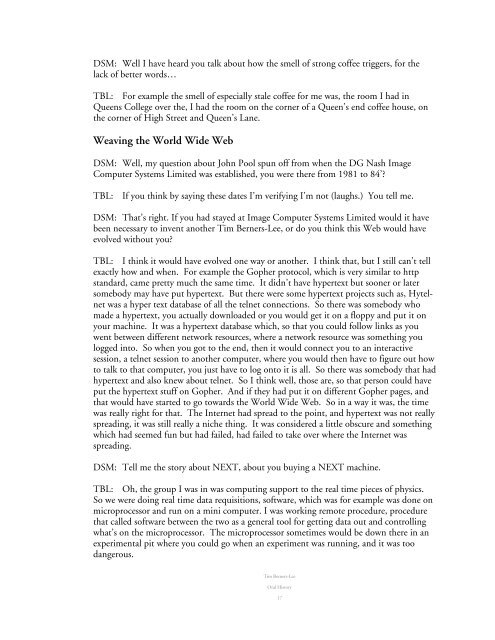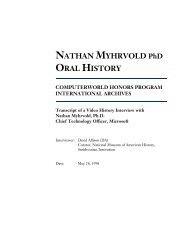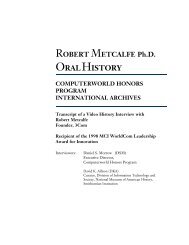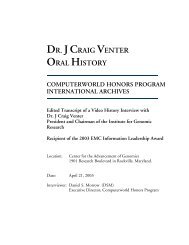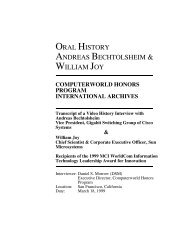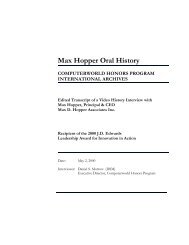My name is Craig Conway - The Computerworld Honors Program
My name is Craig Conway - The Computerworld Honors Program
My name is Craig Conway - The Computerworld Honors Program
Create successful ePaper yourself
Turn your PDF publications into a flip-book with our unique Google optimized e-Paper software.
DSM: Well I have heard you talk about how the smell of strong coffee triggers, for the<br />
lack of better words…<br />
TBL: For example the smell of especially stale coffee for me was, the room I had in<br />
Queens College over the, I had the room on the corner of a Queen’s end coffee house, on<br />
the corner of High Street and Queen’s Lane.<br />
Weaving the World Wide Web<br />
DSM: Well, my question about John Pool spun off from when the DG Nash Image<br />
Computer Systems Limited was establ<strong>is</strong>hed, you were there from 1981 to 84’?<br />
TBL: If you think by saying these dates I’m verifying I’m not (laughs.) You tell me.<br />
DSM: That’s right. If you had stayed at Image Computer Systems Limited would it have<br />
been necessary to invent another Tim Berners-Lee, or do you think th<strong>is</strong> Web would have<br />
evolved without you?<br />
TBL: I think it would have evolved one way or another. I think that, but I still can’t tell<br />
exactly how and when. For example the Gopher protocol, which <strong>is</strong> very similar to http<br />
standard, came pretty much the same time. It didn’t have hypertext but sooner or later<br />
somebody may have put hypertext. But there were some hypertext projects such as, Hytelnet<br />
was a hyper text database of all the telnet connections. So there was somebody who<br />
made a hypertext, you actually downloaded or you would get it on a floppy and put it on<br />
your machine. It was a hypertext database which, so that you could follow links as you<br />
went between different network resources, where a network resource was something you<br />
logged into. So when you got to the end, then it would connect you to an interactive<br />
session, a telnet session to another computer, where you would then have to figure out how<br />
to talk to that computer, you just have to log onto it <strong>is</strong> all. So there was somebody that had<br />
hypertext and also knew about telnet. So I think well, those are, so that person could have<br />
put the hypertext stuff on Gopher. And if they had put it on different Gopher pages, and<br />
that would have started to go towards the World Wide Web. So in a way it was, the time<br />
was really right for that. <strong>The</strong> Internet had spread to the point, and hypertext was not really<br />
spreading, it was still really a niche thing. It was considered a little obscure and something<br />
which had seemed fun but had failed, had failed to take over where the Internet was<br />
spreading.<br />
DSM: Tell me the story about NEXT, about you buying a NEXT machine.<br />
TBL: Oh, the group I was in was computing support to the real time pieces of physics.<br />
So we were doing real time data requ<strong>is</strong>itions, software, which was for example was done on<br />
microprocessor and run on a mini computer. I was working remote procedure, procedure<br />
that called software between the two as a general tool for getting data out and controlling<br />
what’s on the microprocessor. <strong>The</strong> microprocessor sometimes would be down there in an<br />
experimental pit where you could go when an experiment was running, and it was too<br />
dangerous.<br />
Tim Berners-Lee<br />
Oral H<strong>is</strong>tory<br />
17


